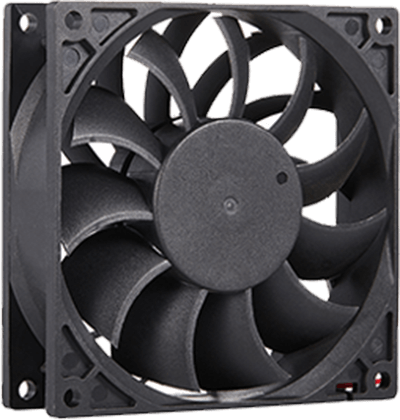Time:2024-07-12 Views:1
DC axial fans are essential components in various electronic devices and equipment, providing efficient cooling to maintain optimal operating temperatures. In this article, we'll delve into the inner workings of DC axial fans, shedding light on their functionality and importance in diverse applications.

Understanding DC Axial Fans
DC axial fans are designed to generate airflow in a linear direction, cooling electronic components such as processors, power supplies, and circuit boards. They operate on the principle of converting electrical energy into mechanical energy, utilizing a rotating impeller to create airflow.
Key Components of DC Axial Fans
Impeller: The impeller is the primary component responsible for generating airflow. It consists of blades or vanes attached to a central hub, which rotates when powered by a DC motor.
DC Motor: The DC motor provides the necessary rotational force to drive the impeller. It converts electrical energy from the power source (such as a battery or power supply) into rotational motion, propelling the impeller to create airflow.
Frame and Housing: The frame and housing enclose the impeller and motor, providing structural support and directing airflow in a specific direction. They also serve to protect the internal components from dust, debris, and external damage.
Bearings: Bearings are used to support the rotating shaft of the motor and impeller, allowing smooth and frictionless movement. They play a crucial role in ensuring the longevity and reliability of the fan.
Electronics: Some DC axial fans may incorporate electronic components such as speed controllers, temperature sensors, and PWM (Pulse Width Modulation) circuits to regulate fan speed and monitor operating conditions.
Functionality of DC Axial Fans
When powered, the DC motor rotates the impeller at a predetermined speed, drawing air into the fan through the intake side. As the impeller blades spin, they create a low-pressure zone behind them, causing air to be sucked in from the surrounding environment. The air is then propelled forward by the rotating impeller and expelled through the exhaust side of the fan, creating a continuous flow of cooling air.
Applications of DC Axial Fans
DC axial fans find widespread use in various industries and applications, including:
Electronics Cooling: One of the primary applications of DC axial fans is in electronics cooling. They are commonly used to dissipate heat generated by electronic components such as CPUs, GPUs, and power supplies in computers, servers, gaming consoles, and networking equipment. DC axial fans help maintain optimal operating temperatures, preventing overheating and ensuring the reliability and longevity of electronic devices.
Automotive Cooling: In the automotive industry, DC axial fans play a crucial role in cooling engine compartments, radiators, and HVAC systems. They help regulate the temperature of internal combustion engines by dissipating heat generated during operation. DC axial fans are also used in electric vehicles (EVs) and hybrid vehicles to cool battery packs and power electronics, contributing to the efficient performance and longevity of automotive systems.
HVAC Systems: Heating, ventilation, and air conditioning (HVAC) systems rely on DC axial fans to circulate air and regulate indoor temperatures in residential, commercial, and industrial buildings. These fans are used in air handlers, condensers, and evaporators to facilitate heat exchange and airflow, ensuring comfortable indoor environments and energy-efficient HVAC operation.
Industrial Applications: DC axial fans find applications in various industrial settings for cooling machinery, equipment, and industrial processes. They are used in heat exchangers, cooling towers, and industrial ovens to dissipate heat generated during manufacturing processes. DC axial fans also contribute to the thermal management of power electronics, transformers, and industrial automation systems, enhancing operational efficiency and reliability.
Medical Equipment: DC axial fans are employed in medical equipment such as MRI machines, X-ray systems, and ultrasound devices to dissipate heat generated by electronic components and maintain stable operating temperatures. They help ensure the accuracy and reliability of medical diagnostics and treatments, contributing to the quality of patient care in healthcare facilities.
Conclusion
In summary, DC axial fans play a critical role in maintaining optimal operating temperatures in electronic devices and equipment. By understanding the inner workings of these fans and their key components, we gain insight into their importance and versatility across diverse applications. As a leading DC axial fan manufacturer, we are committed to delivering high-quality 24V DC cooling fans that meet the unique needs of our customers.